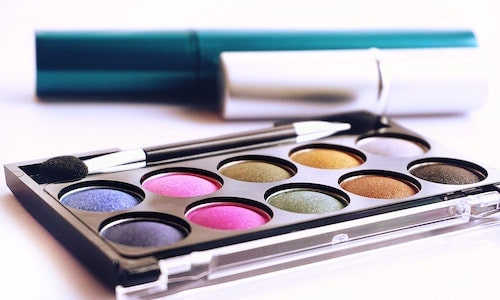Opening the lid to your eye shadow palette when you are getting ready for a night out and finding it covered in a layer of mold is an irritating experience that can ruin your evening.
Fortunately, it’s a fairly rare occurrence, but it does happen, so what do you do if you find mold growing on your eye shadow, can it be saved? Can you still use it, is the mold that’s growing dangerous, and most importantly, how can you prevent this from happening again?
In this article we cover everything you need to know about mold growing on eye shadow, so keep reading.
To prevent mold from growing on eyeshadow, store it away from direct and indirect sources of moisture (such as humid bathrooms). Keep applicators clean and dry to prevent passing bacteria and mold spores from your face into the palette. If mold is found on the eyeshadow, it should be thrown away.

Related articles
Mold On Lipstick: Can It Be Saved? And How To Prevent It
Mold On Makeup: Why It Happens And How To Prevent
Mold On Makeup Brush: How To Clean And Stop It Happening Again
Moldly Beauty Blender? How To Clean Step-By-Step Guide
Can eye shadow grow mold?
Although uncommon, mold certainly can grow on eye shadow and many other forms of cosmetics.
In order for mold to thrive, it only needs a few things, these are:
- A source of nutrients
- A consistent temperature between 60-80 degrees Fahrenheit
- A source of moisture
- A lack of natural sunlight
The moisture content of eye shadow comes from the liquids in the product itself, however, it can also come from using a wet brush to apply the eyeshadow, or from being stored in high-humidity areas, such as the bathroom.
Mold can feed off some of the fats and other products within the eyeshadow, but an additional source of nutrients comes from dust (which is mostly made of dead skin cells) in the air settling onto the palette. This can again be influenced by where it is being stored, as certain areas of the home are more prone to being dusty.
A final option for nutrients comes from skin cells being transferred from your face to the brush, then into the eyeshadow itself. Even small amounts of skin cells are sufficient for mold to use as a source of food.
Temperature is easily explained, as most American homes set their thermostats between 60-90 degrees for many months of the year. This is the perfect range for mold to thrive in and is often why it is seen more frequently in the spring and summer months when the air has higher humidity and the temperatures rise.
Mold hates natural sunlight, as UV rays will kill both mold and its spores upon contact. This is why it is often seen growing in darker areas of a property. If you are storing your eyeshadow in a cupboard or drawer that rarely gets opened, mold will be able to grow happily.
Mold is also far more likely to grow within eyeshadow once it has expired. After this point, the product becomes less stable and begins to deteriorate. This is far more common in eyeshadow that has been formulated without the use of strong chemical preservatives, as these are what usually prevent mold and bacteria from growing in beauty products.
What does mold on eye shadow look like?
Unfortunately, it may be very difficult to spot mold growing in an eyeshadow palette. The patches that it will be growing in could be so small that you might not see them at all, so you are better off using your sense of smell to determine if something isn’t right.
Upon opening the palette, see if you can smell anything unusual. What you are looking for is a smell similar to a musty basement, this is a telltale sign of mold growth.
Of course, if left for a considerable amount of time, the mold growth could be sufficient to be able to see small circular patches of either white, grey, green, or green-blue small powdery or cotton-like growth, this will certainly be mold.
What type of mold grows on eye shadow?
The most common strains of mold found growing within properties (and therefore potentially your eyeshadow), are Cladosporium, Penicillium, and Aspergillus.
These strains of mold can be identified by the following traits:
Cladosporium
Cladosporium mold can be identified by its dark brown, black, or gray-green coloration. It usually forms individual spots, but these can cluster to become one patch. The texture is often described as having a powder or velvety texture.
Penicillium
Penicillium has similar features to Cladosporium, as it is most often seen growing in circular patches, however, these are usually larger than seen with Cladosporium. It can form in a variety of colors, most commonly blue-green, dark green, and even turquoise. Its texture is considered to be velvety or powdery in nature.
Aspergillus
Aspergillus strains appear black on the surface, with a white underside. After some time, the color may change to yellow, brown, or black, and has a texture considered to be either powdery or cottony.
Bear in mind that identification of mold found growing within an eyeshadow palette may be difficult, as the formation could be very small and colors may be difficult to see if they blend into the shades of eyeshadow in the palette. This is why it may be easier to use smell to determine the presence of mold.
Is the mold dangerous?
Unfortunately, the molds mentioned above all have the ability to produce mycotoxins as a defense mechanism whenever they feel threatened.
In some individuals, these mycotoxins may cause several health conditions, including:
- Nausea
- Breathlessness
- Fatigue (in rare cases)
- Skin irritation
The amount of mold or spores you would be exposed to would be small, so serious conditions would be unlikely unless you were allergic to the particular strain of mold growing on your eyeshadow.
Skin irritation is the most likely symptom you may experience when using eyeshadow that contains mold, if the mold were to go unnoticed, you would be applying it directly to your skin.
The most common types of skin irritation caused by exposure to mold are:
- Inflammation
- Eczema
- Acne
- Rashes
What to do if you find mold on your eye shadow
Unfortunately, there is very little you can do to save an eyeshadow palette that has mold growing on it.
Even if you were to scrape off the top layer, the mold may have already established roots deep into the product. Also, as you scrape any visible mold off of the makeup, you may inadvertently release spores, making it very difficult to tell if you have removed all traces of mold, and you could end up spreading it even further.
In reality, frustrating as it may be, should you open your makeup bag and find your eyeshadow has become moldy, the best course of action is to simply throw it away.
How to prevent mold on eye shadow
No one wants to have to keep throwing away makeup, and it’s not cheap, so the best thing you can do to make sure yours doesn’t end up going in the trash, is to prevent mold from growing in the first place. Below are some tips on how you can do just that.
Look out for their expiration dates
Many cosmetics products come with an expiration date for a reason, after the date has passed, the product will begin to deteriorate. This also means any stabilizers and preservatives will become less effective and allow mold and bacteria to grow. The overall quality of the product will also begin to diminish generally, so once your eyeshadow has gone past its expiration date, it’s best to throw it out.
Keep them dry
As stated previously, mold loves moisture, so making sure you keep your eyeshadow tray dry is vital. Whilst applying your eyeshadow, make sure you keep the tray away from any wet areas, for example, if applying in the bathroom, keep it away from mirrors that may have condensation pooling on them, as this could drip onto the palette.
Clean your applicators
Makeup applicators (brushes), can become a hotbed for bacteria and mold if not kept clean. Ensure that you clean out your brushes every few weeks to prevent mold and bacteria from having the nutrients they need from the buildup of dead skin cells. Once cleaned, make sure the brushes are dried as quickly as possible to deny mold the moisture it also needs.
Be careful where you store your makeup
Keeping your eyeshadow dry gives you the best chance of extending its shelf life and preventing mold growth. Along with making sure no water falls directly onto the palette, you also need to be careful about where you store the eyeshadow.
Any areas of the home that frequently have a humidity level greater than 55% provide the correct level of moisture for molds to grow. Therefore, you should store your eyeshadow in drier areas, such as in a well-ventilated closet or drawer.
To keep check of the humidity levels in your bathroom and property in general, you can place a hygrometer in one or several rooms, these units are no larger than a digital alarm clock and will clearly display the humidity within a room. As soon as the room humidity reaches greater than 55%, it’s time to start opening windows, turning on extract fans, and opening doors to increase airflow.
Don’t apply using your fingers
Using your fingers to apply eyeshadow can not only spread bacteria around your eyes but can also add additional moisture to the palette, giving mild a chance to grow. Any bacteria from around your eye can also be passed back onto the palette where it can begin to multiply.
Buy higher quality
Cheaper makeup products may use inferior ingredients and bulking agents to lower their production costs. These products will often expire faster and will contain more moisture to help increase the overall volume of the product. As you’ll remember, the more moisture and lower the quality of preservatives, the faster mold and bacteria will be able to grow.
Conclusion
Mold in eyeshadow is not common, but it certainly does happen. In most cases, a mold-infested palette of eyeshadow cannot be saved and should be thrown away. Keeping your eyeshadow away from direct and indirect moisture, as well as keeping brushes and applicators clean are effective ways to keep your eyeshadow mold-free.

